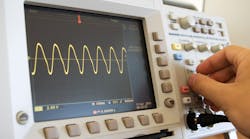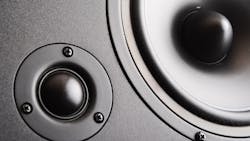This article is part of the Power Management Series: What’s the Difference Between Watts, RMS, and More?
Updated 1/25/2024
In the consumer electronics world, knowing the difference between root mean square (RMS) and peak power ratings can make or break the performance and clarity of an audio system.
In short, RMS power is the average amount of continuous power that an amplifier can output or a speaker can handle over time without being damaged. Peak power takes endurance out of the equation: It is the absolute maximum power that an amplifier can output, or that a speaker can handle before damage occurs.
When you see a power rating of, for instance, 100 W RMS, it means that the amplifier can output 100 W continuously or that the speaker can handle 100 W continuously. When you see a peak power rating of 200 W, it means that the amplifier can output 200 W for short periods of time, or that the speaker can handle a rush of up to 200 W.
The truth is that speakers with high peak watts may appear to be more powerful than those with lower power ratings. However, they don't provide the best sound quality. The RMS power rating is a better indicator of the true power of a speaker. The same can be said about subwoofers, as those with a higher RMS rating tend to sound clean and full when the volume is cranked.
The maximum power and continuous power ratings are among the essential factors that contribute to an ideal sound system. Thus, it’s important to know what these two values refer to when designing or purchasing speakers, amplifiers, or subwoofers.
It may make sense to favor audio and sound equipment with the highest power ratings. However, this may prove difficult for anyone who doesn’t fully understand the difference between RMS and peak watts. Therefore, it’s helpful to have basic information on power ratings (Fig. 1). This comprehensive guide will help you understand these two values to assist in assembling a sound system.
RMS power, or root mean square power, is the continuous power that an amplifier can output, or that a speaker can handle. It's the average power that the amplifier or speaker can handle over time. In other words, it's the power that the amplifier or speaker can handle for long periods of time without being damaged.
Peak power, on the other hand, is the maximum power that an amplifier can output, or that a speaker can handle. It's the maximum power that the amplifier or speaker can handle for short periods of time without being damaged.
So, when you see a power rating of, say, 100 W RMS, it means that the amplifier can output 100 W continuously, or that the speaker can handle 100 W continuously. When you see a power rating of, say, 200 W peak, it means that the amplifier can output 200 W for short periods of time, or that the speaker can handle 200 W for short periods of time.
The truth is that speakers with high peak watts may appear to be more powerful than those with lower power ratings. However, they don't provide the best sound quality. The RMS power rating is a better indicator of the true power of a speaker. The same can be said about subwoofers, as those with a higher RMS rating tend to sound clean and full when the volume is cranked.
RMS Watts Explained
Root mean square or simply RMS watts refers to continuous power handling of a speaker or a subwoofer or how much continuous power an amplifier can output. RMS values are usually lower than peak watts ratings, but they represent what a unit is truly capable of handling. Think of RMS power as the average power that a speaker can handle on a daily basis without compromising sound quality or experiencing any distortion.
Peak Watts Explained
The peak power handling is the highest power level that a speaker or a subwoofer can handle in a short burst without blowing. The same holds for amplifiers as the absolute highest amount of power they can put out before failing or without resulting in distortion.
We can think of peak watts as the number atop of your car's speedometer. For example, you can drive for maybe 180km/h, but you can't sustain that speed for long without causing mechanical or thermal damage to the car. In the same way, the peak power level can only be maintained for a fraction of a second, although there’s no clear definition of how long.
If the unit is subjected to constant peak power, the wires may overheat, which could quickly damage the voice coils.
RMS Power vs. Peak Power
When shopping around, you'll notice that some manufacturers rate their products' power-handling capabilities using either the peak watts rating or RMS rating, while most use both values. For example, a unit can be rated at 150 W while another brand may be advertised at 75 W.
At first glance, one might be tempted to think that the former is better because it’s rated at a higher power level than the latter. However, upon a closer look, you may notice that the first product is rated for peak watts while the second one is advertising RMS watts. Typically, a unit’s peak power handling is double the RMS power handling, which basically means that the above products are actually rated the same: 150 W peak/75 W RMS.
Most audio equipment manufacturers, though, prefer to stress more on the peak power rating to make the products look like they deliver more power than they’re capable of. While this may sound convincing, utilizing peak power not only disturbs your neighbors, but also makes your sound equipment depreciate in value, requiring you to replace some parts or buy a new unit altogether. As such, if you want to your speaker to last for years, the figure to look out for is the RMS wattage, the power input at which you should be enjoying your music.
However, when it comes to these technical details, don't get confused by speaker power ratings and amplifier specifications. Amplifiers generate power in an audio system, which is not the case with speakers and subwoofers. Therefore, speaker power ratings refer to the amount of power your speakers can handle from an amplifier. The specifications on the amp, on the other hand, refer to how much power it can produce for maximum audio performance.
Conclusion
Both RMS and peak watts play an important role in your sound system, and they’re vital when comparing your speakers with amplifiers or subwoofers. When matching speakers or subwoofers to amplifiers, you should compare either two RMS values or two peak ratings. That said, buyers or builders shouldn’t use both peak and RMS to compare speakers and amplifiers or subwoofers, as they could end up with a sound that’s either muted or tinny.
The difference between peak watts and RMS watts is that peak watts are the maximum output, while RMS watts are the average output. For example, a speaker with a peak wattage of 100 W and an RMS wattage of 40 W will play at its highest volume for approximately 10 seconds before it starts to sound distorted. A speaker with a peak wattage of 100 W and an RMS wattage of 80 W will sound better. It will be able to handle the peaks without sounding distorted, and it will produce a louder, fuller sound overall.
Now that you know the difference between peak watts and RMS watts, you can start to narrow down your choices for amplifiers, subwoofers, and speakers. Remember, when matching speakers and amplifiers or subwoofers, you should compare either two RMS values or two peak ratings.
Read more from the Power Management Series: What’s the Difference Between Watts, RMS, and More?
David M. Foster is Head of Content at SpeakerChampion.
Originally published on January 17, 2020.

